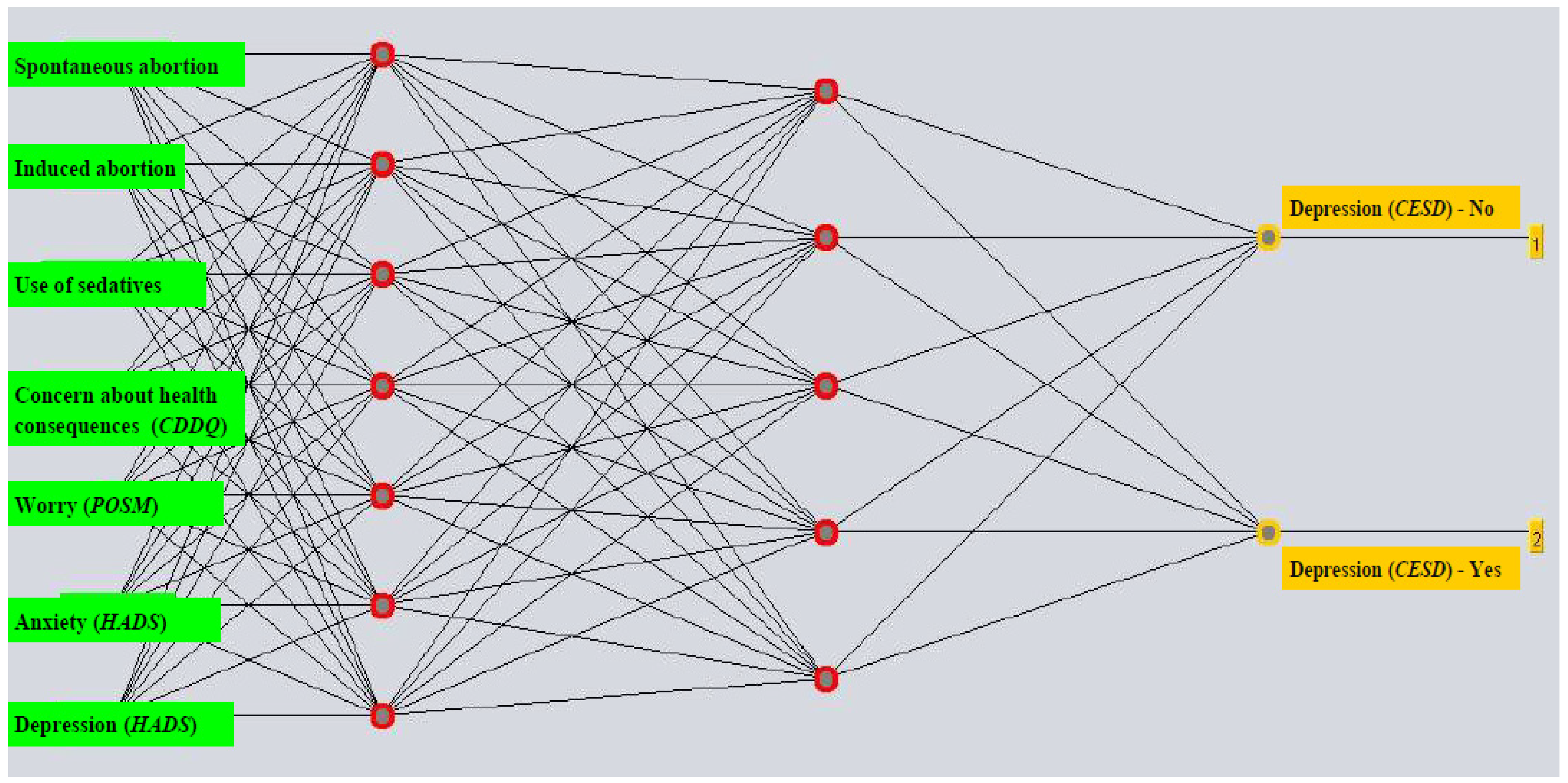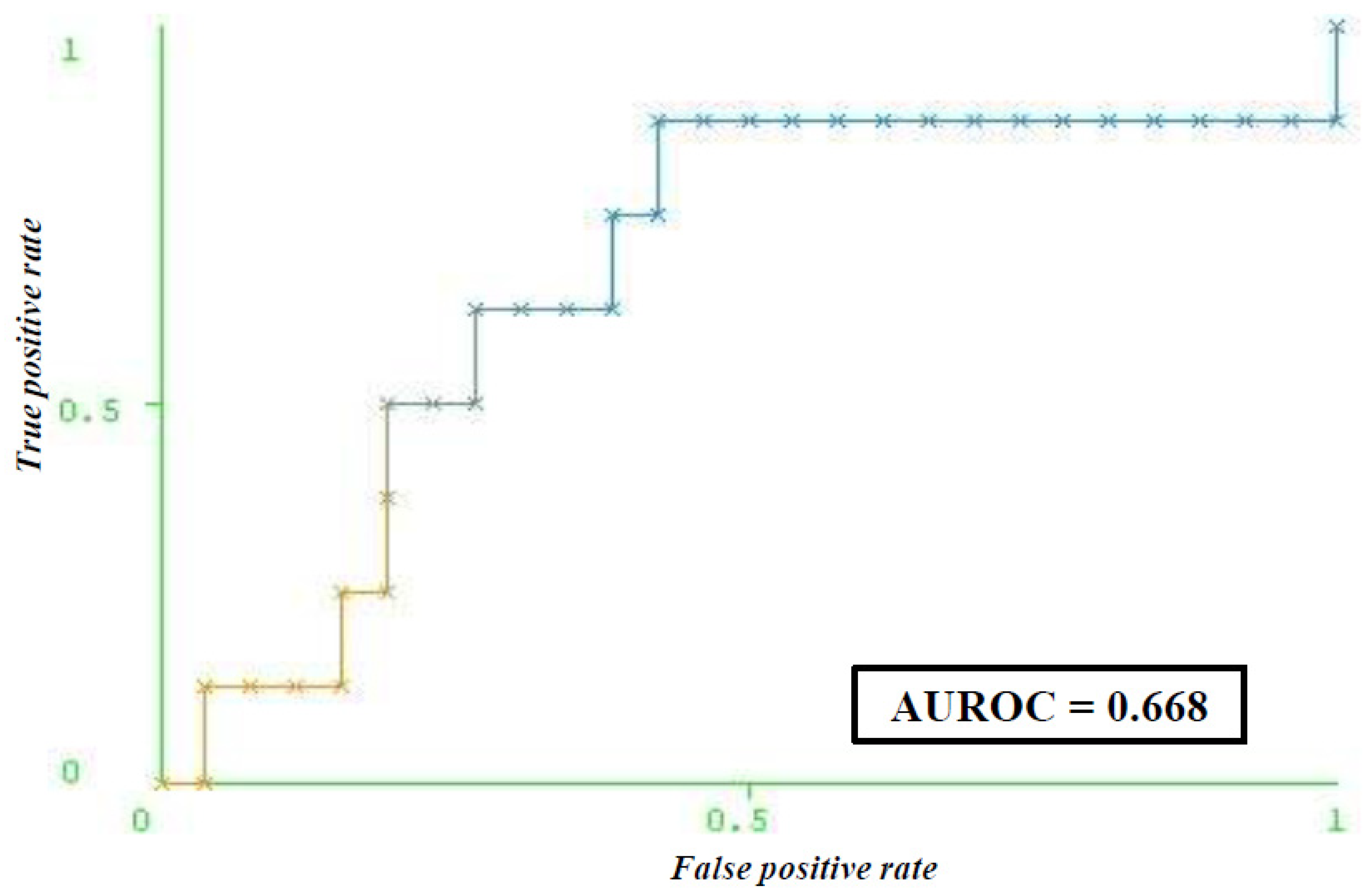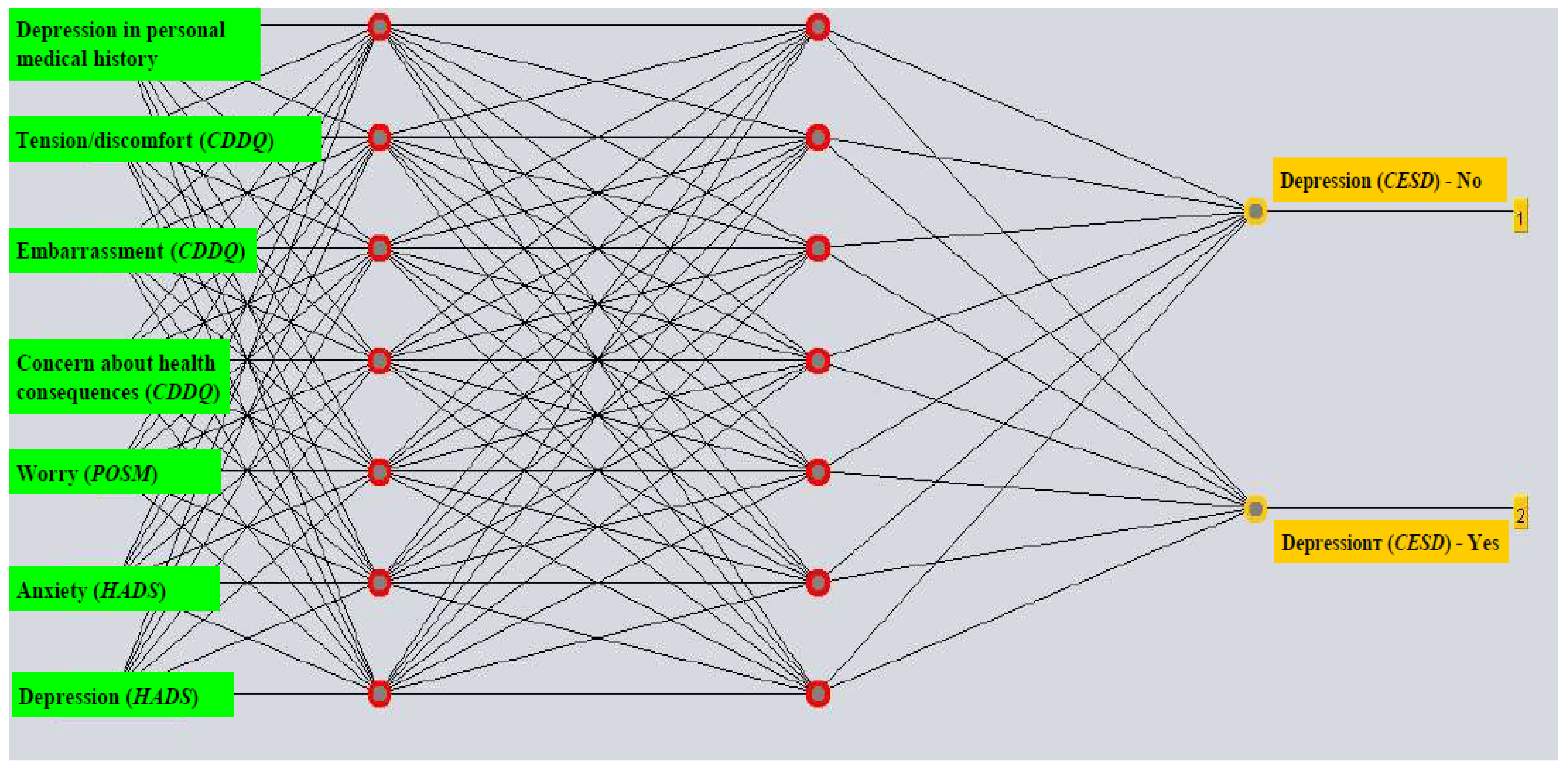An Artificial Neural Network Prediction Model of Depressive Symptoms among Women with Abnormal Papanicolaou Smear Results before and after Diagnostic Procedures
Abstract
1. Introduction
2. Methodology
2.1. Setting
2.2. Study Design
2.3. Study Sample
2.4. Sample Size Calculation
2.5. Data Collection
2.6. Instruments
2.7. Ethical Considerations
2.8. Statistical Analysis
3. Results
4. Discussion
Strengths and Limitations of the Research
5. Conclusions
Supplementary Materials
Author Contributions
Funding
Institutional Review Board Statement
Informed Consent Statement
Data Availability Statement
Acknowledgments
Conflicts of Interest
References
- Ferlay, J.; Ervik, M.; Lam, F.; Laversanne, M.; Colombet, M.; Mery, L.; Pineros, M.; Znaor, A.; Soerjomataram, I.; Bray, F. Global Cancer Observatory: Cancer Today. Lyon, France: International Agency for Research on Cancer. 2024. Available online: https://gco.iarc.who.int/toda (accessed on 2 April 2024).
- Pettersson, B.F.; Hellman, K.; Vaziri, R.; Andersson, S.; Hellström, A.C. Cervical cancer in the screening era: Who fell victim in spite of successful screening programs? J. Gynecol. Oncol. 2011, 22, 76–82. [Google Scholar] [CrossRef] [PubMed]
- Simonella, L.; Canfell, K. The impact of a two- versus three-yearly cervical screening interval recommendation on cervical cancer incidence and mortality: An analysis of trends in Australia, New Zealand, and England. Cancer Causes Control 2013, 24, 1727–1736. [Google Scholar] [CrossRef] [PubMed]
- Vaccarella, S.; Franceschi, S.; Engholm, G.; Lönnberg, S.; Khan, S.; Bray, F. 50 years of screening in the Nordic countries: Quantifying the effects on cervical cancer incidence. Br. J. Cancer 2014, 111, 965–969. [Google Scholar] [CrossRef] [PubMed]
- Ilic, M.; Ilic, I. Cancer mortality in Serbia, 1991-2015: An age-period-cohort and joinpoint regression analysis. Cancer Commun. 2018, 38, 10. [Google Scholar] [CrossRef] [PubMed]
- Solomon, D.; Davey, D.; Kurman, R.; Moriarty, A.; O‘Connor, D.; Prey, M.; Raab, S.; Sherman, M.; Wilbur, D.; Wright, T.; et al. The 2001 Bethesda System: Terminology for reporting results of cervical cytology. JAMA 2002, 287, 2114–2119. [Google Scholar] [CrossRef]
- Institute of Public Health of Serbia “Dr Milan Jovanović Batut”; National Cancer Screening Office. Cervical Screening Programme; Institute of Public Health of Serbia “Dr Milan Jovanović Batut”: Belgrade, Serbia, 2024; Available online: https://www.skriningsrbija.rs/eng/cervical-cancer-screening/ (accessed on 24 August 2024).
- Alrajjal, A.; Pansare, V.; Choudhury, M.S.R.; Khan, M.Y.A.; Shidham, V.B. Squamous intraepithelial lesions (SIL: LSIL, HSIL, ASCUS, ASC-H, LSIL-H) of Uterine Cervix and Bethesda System. Cytojournal 2021, 18, 16. [Google Scholar] [CrossRef]
- Baldur-Felskov, B.; Munk, C.; Nielsen, T.S.; Dehlendorff, C.; Kirschner, B.; Junge, J.; Kjaer, S.K. Trends in the incidence of cervical cancer and severe precancerous lesions in Denmark, 1997–2012. Cancer Causes Control. 2015, 26, 1105–1116. [Google Scholar] [CrossRef]
- Breitkopf, C.R.; Dawson, L.; Grady, J.J.; Breitkopf, D.M.; Nelson-Becker, C.; Snyder, R.R. Intervention to improve follow-up for abnormal Papanicolaou tests: A randomized clinical trial. Health Psychol. 2014, 33, 307–316. [Google Scholar] [CrossRef]
- Miller, S.M.; Tagai, E.K.; Wen, K.Y.; Lee, M.; Hui, S.A.; Kurtz, D.; Scarpato, J.; Hernandez, E. Predictors of adherence to follow-up recommendations after an abnormal Pap smear among underserved inner-city women. Patient Educ. Couns. 2017, 100, 1353–1359. [Google Scholar] [CrossRef]
- Martinez-Gutierrez, J.; Chima, S.; Boyd, L.; Sherwani, A.; Drosdowsky, A.; Karnchanachari, N.; Luong, V.; Reece, J.C.; Emery, J. Failure to follow up abnormal test results associated with cervical cancer in primary and ambulatory care: A systematic review. BMC Cancer 2023, 23, 653. [Google Scholar] [CrossRef]
- Sharp, L.; Cotton, S.; Cruickshank, M.; Gray, N.; Smart, L.; Whynes, D.; Little, J.; TOMBOLA Group. Impact of post-colposcopy management on women’s long-term worries: Results from the UK population-based TOMBOLA trial. J. Fam. Plan. Reprod. Health Care 2016, 42, 43–51. [Google Scholar] [CrossRef] [PubMed]
- Sharp, L.; Cotton, S.; Little, J.; Gray, N.M.; Cruickshank, M.; Smart, L.; Thornton, A.; Waugh, N.; Walker, L.; TOMBOLA Group. Psychosocial impact of alternative management policies for low-grade cervical abnormalities: Results from the TOMBOLA randomised controlled trial. PLoS ONE 2013, 8, e80092. [Google Scholar] [CrossRef]
- Orbell, S.; Hagger, M.; Brown, V.; Tidy, J. Appraisal theory andemotional sequelae of first visit to colposcopy following anabnormal cervical screening result. Br. J. Health Psychol. 2004, 9, 533–555. [Google Scholar] [CrossRef] [PubMed]
- Gath, D.H.; Hallam, N.; Mynors-Wallis, L.; Day, A.; Bond, S.A. Emotional reactions in women attending a UK colposcopy clinic. J. Epidemiol. Community Health 1995, 49, 79–83. [Google Scholar] [CrossRef]
- O‘Connor, M.; Gallagher, P.; Waller, J.; Martin, C.M.; O‘Leary, J.J.; Sharp, L. Irish Cervical Screening Research Consortium (CERVIVA). Adverse psychological outcomes following colposcopy and related procedures: A systematic review. BJOG 2016, 123, 24–38. [Google Scholar] [CrossRef]
- Bell, S.; Porter, M.; Kitchener, H.; Fraser, C.; Fisher, P.; Mann, E. Psychological response to cervical screening. Prev. Med. 1995, 24, 610–616. [Google Scholar] [CrossRef] [PubMed]
- Hellsten, C.; Sjöström, K.; Lindqvist, P.G. A 2-year follow-up study of anxiety and depression in women referred for colposcopy after an abnormal cervical smear. BJOG 2008, 115, 212–218. [Google Scholar] [CrossRef]
- Sharp, L.; Cotton, S.; Gray, N.; Avis, M.; Russell, I.; Walker, L.; Waugh, N.; Whynes, D.; Woolley, C.; Thornton, A.; et al. Long-term psychosocial impact of alternative management policies in women with low-grade abnormal cervical cytology referred for colposcopy: A randomised controlled trial. Br. J. Cancer 2011, 104, 255–264. [Google Scholar] [CrossRef]
- Zigmond, A.S.; Snaith, R.P. The hospital anxiety and depression scale. Acta Psychiatr. Scand. 1983, 67, 361–370. [Google Scholar] [CrossRef]
- Radloff, L.S. The CES-D scale: A self-report depression scale for research in the general population. Appl. Psychol. Meas. 1977, 1, 385–401. [Google Scholar] [CrossRef]
- Shinn, E.; Basen-Engquist, K.; Le, T.; Hansis-Diarte, A.; Bostic, D.; Martinez-Cross, J.; Santos, A.; Follen, M. Distress after an abnormal Pap smear result: Scale development and psychometric validation. Prev. Med. 2004, 39, 404–412. [Google Scholar] [CrossRef]
- Gray, N.M.; Sharp, L.; Cotton, S.C.; Avis, M.; Philips, Z.; Russell, I.; Walker, L.G.; Whynes, D.; Little, J.; TOMBOLA Group. Developing a questionnaire to measure the psychosocial impact of an abnormal cervical smear result and its subsequent management: The TOMBOLA (Trial of Management of Borderline and Other Low-grade Abnormal Smears) trial. Qual. Life Res. 2005, 14, 1553–1562. [Google Scholar] [CrossRef] [PubMed]
- Scheid, T.; Brown, T. (Eds.) Approaches to Mental Health and Illness: Conflicting Definitions and Emphases. In A Handbook for the Study of Mental Health: Social Contexts, Theories, and Systems; Cambridge University Press: Cambridge, UK, 2009; pp. 1–162. [Google Scholar]
- Ilic, I.; Babic, G.; Dimitrijevic, A.; Ilic, M.; Sipetic Grujicic, S. Internal consistency and validity of the Hospital Anxiety and Depression Scale (HADS) in women with abnormal Pap smear in Serbia. Women Health 2021, 61, 363–371. [Google Scholar] [CrossRef]
- Ilic, I.; Babic, G.; Dimitrijevic, A.; Ilic, M.; Sipetic Grujicic, S. Reliability and validity of the Center for Epidemiologic Studies Depression (CES-D) scale in Serbian women with abnormal Papanicolaou smear results. Int. J. Gynecol. Cancer 2019, 29, 996–1002. [Google Scholar] [CrossRef] [PubMed]
- Ilic, I.; Babic, G.; Dimitrijevic, A.; Ilic, M.; Sipetic Grujicic, S. Psychological distress among women with abnormal pap smear results in Serbia: Validity and reliability of the Cervical Dysplasia Distress Questionnaire. PLoS ONE 2019, 14, e0218070. [Google Scholar] [CrossRef]
- Ilic, I. Assessment of Anxiety and Depression in Women with Positive Papanicolaou Screening Test before and after Diagnostic Procedures. Ph.D. Dissertation, Faculty of Medical Sciences, University of Kragujevac, Kragujevac, Serbia, 2019. Available online: https://nardus.mpn.gov.rs/handle/123456789/12014?show=full&locale-attribute=sr_RS (accessed on 2 April 2024).
- Phuakpoolpol, S.; Suwannarurk, K.; Jaisin, K.; Punyashthira, A.; Pattaraarchachai, J.; Bhamarapravatana, K. Anxiety and Depression in Thai Women with Abnormal Cervical Cytology who Attended Colposcopic Unit in Thammasat University Hospital. Asian Pac. J. Cancer Prev. 2018, 19, 2985–2989. [Google Scholar] [CrossRef] [PubMed]
- Rask, M.; Swahnberg, K.; Oscarsson, M. Swedish women’s awareness of human papillomavirus, and health-related quality of life, anxiety, and depression after a notification of an abnormal Pap smear result: A cross-sectional study. Eur. J. Cancer Prev. 2019, 28, 96–101. [Google Scholar] [CrossRef] [PubMed]
- Valdini, A.; Esielionis, P. Measurement of colposcopy-associated distress using the psychosocial effects of having an abnormal pap smear-questionnaire in a Latina population. J. Low. Genit. Tract. Dis. 2004, 8, 25–32. [Google Scholar] [CrossRef]
- Cotton, S.C.; Sharp, L.; Little, J.; Gray, N.M.; Walker, L.G.; Whynes, D.K.; Cruickshank, M.E.; TOMBOLA Group. A normal colposcopy examination fails to provide psychological reassurance for women who have had low-grade abnormal cervical cytology. Cytopathology 2015, 26, 178–187. [Google Scholar] [CrossRef]
- Oscarsson, M.G.; Benzein, E.G.; Wijma, B.E. Reasons for non-attendance at cervical screening as reported by non-attendees in Sweden. J. Psychosom. Obstet. Gynaecol. 2008, 29, 23–31. [Google Scholar] [CrossRef]
- Rogstad, K. The psychological impact of abnormal cytology and colposcopy. Br. J. Obstet. Gynaecol. 2002, 109, 364–368. [Google Scholar] [CrossRef] [PubMed]
- O‘Connor, M.; O‘Brien, K.; Waller, J.; Gallagher, P.; D‘Arcy, T.; Flannelly, G.; Martin, C.M.; McRae, J.; Prendiville, W.; Ruttle, C.; et al. Irish Cervical Screening Research Consortium (CERVIVA). Physical after-effects of colposcopy and related procedures, and their inter-relationship with psychological distress: A longitudinal survey. BJOG 2017, 124, 1402–1410. [Google Scholar] [CrossRef] [PubMed]
- Kelly, K.M.; Schoenberg, N.; Wilson, T.D.; Atkins, E.; Dickinson, S.; Paskett, E. Cervical cancer worry and screening among appalachian women. J. Prim. Prev. 2015, 36, 79–92. [Google Scholar] [CrossRef]
- Uner, F.O.; Korukcu, O. A prevalence and psychometric study on fear of cancer in women with abnormal cervical cytology undergoing colposcopy. Psychooncology 2020, 29, 1850–1855. [Google Scholar] [CrossRef] [PubMed]
- Lofters, A.K.; Telner, D.; Kalia, S.; Slater, M. Association Between Adherence to Cancer Screening and Knowledge of Screening Guidelines: Feasibility Study Linking Self-Reported Survey Data With Medical Records. JMIR Cancer 2018, 4, e10529. [Google Scholar] [CrossRef]
- Hansen, B.T.; Hukkelberg, S.S.; Haldorsen, T.; Eriksen, T.; Skare, G.B.; Nygård, M. Factors associated with non-attendance, opportunistic attendance and reminded attendance to cervical screening in an organized screening program: A cross-sectional study of 12,058 Norwegian women. BMC Public. Health 2011, 11, 264. [Google Scholar] [CrossRef]
- Zhang, X.; Mkuu, R.; Samman, E.; Cummings, S.; Sherman, L.; Wigfall, L.T.; Wilkinson, L.; Burdine, J.N. Anxiety and depressive symptoms and missing breast cancer and cervical screening: Results from Brazos valley community health survey. Psychol. Health Med. 2020, 25, 402–409. [Google Scholar] [CrossRef]
- Horsbøl, T.A.; Kjaer, S.K.; Andersen, E.W.; Ammitzbøll, G.; Thygesen, L.C.; Johansen, C.; Jensen, P.T.; Frøding, L.P.; Lajer, H.; Dalton, S.O. Use of hypnotics among women diagnosed with cervical cancer—A population-based cohort study. Gynecol. Oncol. 2022, 166, 300–307. [Google Scholar] [CrossRef]
- Farren, J.; Jalmbrant, M.; Falconieri, N.; Mitchell-Jones, N.; Bobdiwala, S.; Al-Memar, M.; Tapp, S.; Van Calster, B.; Wynants, L.; Timmerman, D.; et al. Posttraumatic stress, anxiety and depression following miscarriage and ectopic pregnancy: A multicenter, prospective, cohort study. Am. J. Obstet. Gynecol. 2020, 222, e1–e367. [Google Scholar] [CrossRef]
- Giannandrea, S.A.; Cerulli, C.; Anson, E.; Chaudron, L.H. Increased risk for postpartum psychiatric disorders among women with past pregnancy loss. J. Womens Health 2013, 22, 760–768. [Google Scholar] [CrossRef]
- Gebeyehu, N.A.; Tegegne, K.D.; Abebe, K.; Asefa, Y.; Assfaw, B.B.; Adella, G.A.; Alemu, B.W.; Sewyew, D.A. Global prevalence of post-abortion depression: Systematic review and Meta-analysis. BMC Psychiatry 2023, 23, 786. [Google Scholar] [CrossRef] [PubMed]
- Hope, H.; Pierce, M.; Johnstone, E.D.; Myers, J.; Abel, K.M. The sexual and reproductive health of women with mental illness: A primary care registry study. Arch. Womens Ment. Health 2022, 25, 585–593. [Google Scholar] [CrossRef] [PubMed]
- Gebreegziabher, Z.A.; Semagn, B.E.; Kifelew, Y.; Abebaw, W.A.; Tilahun, W.M. Cervical cancer screening and its associated factors among women of reproductive age in Kenya: Further analysis of Kenyan demographic and health survey 2022. BMC Public Health 2024, 24, 741. [Google Scholar] [CrossRef] [PubMed]
- Debray, T.P.; Collins, G.S.; Riley, R.D.; Snell, K.I.; Van Calster, B.; Reitsma, J.B.; Moons, K.G. Transparent reporting of multivariable prediction models developed or validated using clustered data (TRIPOD-Cluster): Explanation and elaboration. BMJ 2023, 380, e071018. [Google Scholar] [CrossRef]
- Collins, G.S.; Moons, K.G.M.; Dhiman, P.; Riley, R.D.; Beam, A.L.; Van Calster, B.; Ghassemi, M.; Liu, X.; Reitsma, J.B.; van Smeden, M.; et al. TRIPOD+AI statement: Updated guidance for reporting clinical prediction models that use regression or machine learning methods. BMJ 2024, 385, e078378. [Google Scholar] [CrossRef]




| Variables | Depression—Present | ||||
|---|---|---|---|---|---|
| Total | Before Diagnostic Procedures | After Diagnostic Procedures | |||
| Number (%) | Number (%) | p * | Number (%) | p *,** | |
| Age (years) | |||||
| 12 (7.0) | 6 (9.5) | 7 (12.7) | ||
| 43 (25.0) | 12 (19.0) | 8 (14.5) | ||
| 42 (24.4) | 18 (28.6) | 17 (30.9) | ||
| 51 (29.7) | 18 (28.6) | 14 (25.5) | ||
| 24 (14.0) | 9 (14.3) | 0.582 | 9 (16.4) | 0.056 * |
| Place of residence | |||||
| 45 (26.2) | 21 (33.3) | 18 (32.7) | ||
| 127 (73.8) | 42 (66.7) | 0.155 | 37 (67.3) | 0.268 |
| Education level | |||||
| 37 (21.5) | 11 (17.5) | 11 (20.0) | ||
| 135 (78.5) | 52 (82.5) | 0.441 | 44 (80.0) | 0.843 |
| Marital status | |||||
| 33 (19.2) | 13 (20.6) | 11 (20.0) | ||
| 139 (80.8) | 50 (79.4) | 0.841 | 44 (80.0) | 0.838 |
| Depression (CES-D score ≥ 16) | |||||
| 109 (63.4) | 117 (68.0) | |||
| 63 (36.6) | 55 (32.0) | 0.364 * | ||
| Mean ± Standard Deviation | 13.98 ± 9.56 | 12.74 ± 9.15 | 0.025 ** | ||
| Range | 0–43 | 0–38 | |||
| Attributes | Depression—Before Depression—After | |
|---|---|---|
| Pearson Correlation Coefficient | ||
| HADS depression score | 0.52741 | 0.41952 |
| HADS anxiety score | 0.46719 | 0.42443 |
| POSM Worry score | 0.29532 | 0.29432 |
| CDDQ score for concern about health consequences | 0.21773 | 0.20956 |
| Use of sedatives | 0.24591 | |
| Induced abortion | 0.21501 | |
| Spontaneous abortion | 0.20992 | |
| CDDQ score for Tension/discomfort | 0.25198 | |
| Depression in personal medical history | 0.22991 | |
| CDDQ score for Embarrassment | 0.21929 | |
| Evaluation Metrics | Model: Training + Validation Set ** with All Attributes | Model: Test Set with All Attributes | Model: Training + Validation Set ** with Selected Attributes |
Model: Test Set with Selected Attributes |
|---|---|---|---|---|
| Accuracy | 71.0145% | 64.7059% | 71.7391% | 70.5882% |
| Kappa | 0.395 | 0.097 | 0.419 | 0.182 |
| TP Rate * | 0.710 | 0.647 | 0.717 | 0.706 |
| FP Rate * | 0.315 | 0.541 | 0.292 | 0.523 |
| Precision * (PPV) | 0.710 | 0.676 | 0.723 | 0.706 |
| NPV | 0.555 | 0.300 | 0.633 | 0.375 |
| ROC Area * | 0.787 | 0.572 | 0.762 | 0.668 |
| MCC | 0.395 | 0.098 | 0.421 | 0.183 |
| Evaluation Metrics | Model: Training + Validation Set ** with All Attributes | Model: Test Set with All Attributes | Model: Training + Validation Set ** with Selected Attributes |
Model: Test Set with Selected Attributes |
|---|---|---|---|---|
| Accuracy | 68.1159% | 58.8235% | 72.4638% | 70.5882% |
| Kappa | 0.310 | 0.044 | 0.415 | 0.317 |
| TP Rate * | 0.681 | 0.588 | 0.725 | 0.706 |
| FP Rate * | 0.364 | 0.530 | 0.293 | 0.288 |
| Precision * (PPV) | 0.688 | 0.690 | 0.738 | 0.798 |
| NPV | 0.538 | 0.230 | 0.589 | 0.384 |
| ROC Area * | 0.680 | 0.593 | 0.744 | 0.836 |
| MCC | 0.311 | 0.048 | 0.419 | 0.348 |
Disclaimer/Publisher’s Note: The statements, opinions and data contained in all publications are solely those of the individual author(s) and contributor(s) and not of MDPI and/or the editor(s). MDPI and/or the editor(s) disclaim responsibility for any injury to people or property resulting from any ideas, methods, instructions or products referred to in the content. |
© 2024 by the authors. Licensee MDPI, Basel, Switzerland. This article is an open access article distributed under the terms and conditions of the Creative Commons Attribution (CC BY) license (https://creativecommons.org/licenses/by/4.0/).
Share and Cite
Ilic, I.; Babic, G.; Dimitrijevic, A.; Sipetic Grujicic, S.; Ilic, M. An Artificial Neural Network Prediction Model of Depressive Symptoms among Women with Abnormal Papanicolaou Smear Results before and after Diagnostic Procedures. Life 2024, 14, 1130. https://doi.org/10.3390/life14091130
Ilic I, Babic G, Dimitrijevic A, Sipetic Grujicic S, Ilic M. An Artificial Neural Network Prediction Model of Depressive Symptoms among Women with Abnormal Papanicolaou Smear Results before and after Diagnostic Procedures. Life. 2024; 14(9):1130. https://doi.org/10.3390/life14091130
Chicago/Turabian StyleIlic, Irena, Goran Babic, Aleksandra Dimitrijevic, Sandra Sipetic Grujicic, and Milena Ilic. 2024. "An Artificial Neural Network Prediction Model of Depressive Symptoms among Women with Abnormal Papanicolaou Smear Results before and after Diagnostic Procedures" Life 14, no. 9: 1130. https://doi.org/10.3390/life14091130
APA StyleIlic, I., Babic, G., Dimitrijevic, A., Sipetic Grujicic, S., & Ilic, M. (2024). An Artificial Neural Network Prediction Model of Depressive Symptoms among Women with Abnormal Papanicolaou Smear Results before and after Diagnostic Procedures. Life, 14(9), 1130. https://doi.org/10.3390/life14091130






